IBM history
IBM is one of the world's largest manufacturers and suppliers of hardware and software. The company has existed for more than a hundred years; throughout this period, it has led technological progress. Largely thanks to her, we have magnetic stripe cards, hard drives and personal computers.
We'll talk about the US air defense, the first programmable computer, alternative use of production capacity (for the production of rifles), the first mass IBM PC, the ThinkPad notebook line and inventions that have come into our lives for many years.

At the origins of IBM stood Herman Hollerith , an American inventor. He was born into a family of German émigrés, graduated from Columbia University Mining School, became an assistant to Professor W. Trubridge at Columbia, and then assisted him at the census bureau. In the 1880s, Hollerith developed and patented equipment for working with punch cards , which were used in weaving looms since the early 1700s, and from 1822 they were used in a difference machine by Charles Babbage .
')
The invention of the electric tabulation system allowed Hollerith to speed up the process of counting population census results. If we spent eight years on the counting in 1880, then in 1890, thanks to the tabulator, the bureau left it for one year. After the census in the United States, Hollerith was promoted to professor at Columbia University. During the following years, his invention was used to conduct censuses in several countries, including Austria, Canada, Italy, and France. Understanding the potential of his invention, Hollerith in 1896 opens the Tabulating Machine Company. TMC sells its cars to railway companies, government agencies, and international trade.
In Russia, until the end of the XIX century there was no accurate data on the population. These figures are important for the state as a minimum in order to calculate the number of citizens liable for military service, as well as for solving a host of other issues of governing the country.
 In August 1895, N. A. Troinitsky, Director of the Center for Statistics, at the session of the International Statistical Institute presented to the colleagues the Regulation on the General Census in Russia scheduled for 1897 . Hollerith also spoke at this session. A year after this meeting, Hollerith was invited to Russia to sign a contract and conduct a census. The Tabulating Machine Company, which Hollerith opened in 1896, provided Russia with 35 previously used cars for rent and sold 70 tabulators with sorting machines and 500 rotary hammers. To reduce the cost of transporting equipment, some parts were produced on site, in St. Petersburg.
In August 1895, N. A. Troinitsky, Director of the Center for Statistics, at the session of the International Statistical Institute presented to the colleagues the Regulation on the General Census in Russia scheduled for 1897 . Hollerith also spoke at this session. A year after this meeting, Hollerith was invited to Russia to sign a contract and conduct a census. The Tabulating Machine Company, which Hollerith opened in 1896, provided Russia with 35 previously used cars for rent and sold 70 tabulators with sorting machines and 500 rotary hammers. To reduce the cost of transporting equipment, some parts were produced on site, in St. Petersburg.
The complete set consisted of one tabulator, which summarized the signs of the same name, thirty punchers for preparing punched cards, two sorting machines for grouping cards. Census sheets were sent to headquarters, in this case, to the Center of statistical control of the Russian Empire. More than two and a half thousand people worked here in several departments. In the markup opposite the answers, the code of the sign was put, in the check mark - they checked if there were any errors, and in the breakdown code the codes were transferred to punch cards, each of which corresponded to one person. The last branch, machine, made calculations using tabs and sorting machines. It counted the results and grouped punch cards. Unfortunately, in Russia, the census took eight years because of the negligence of some of the people responsible for the process.
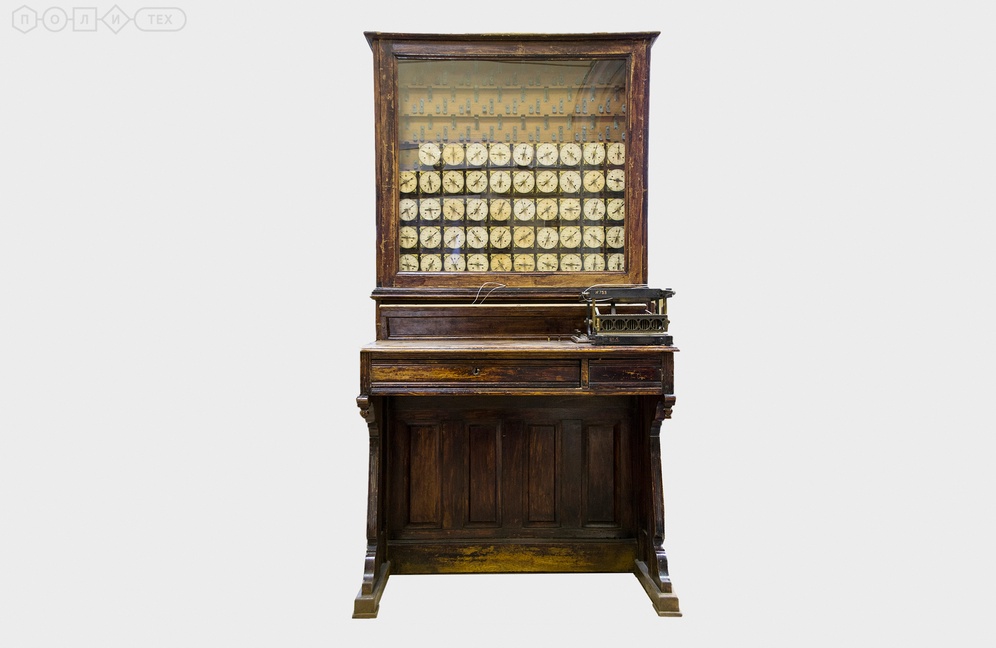
The last tabulator that was used during the census in the Russian Empire. Photo: Polytechnic Museum
In 1901, in parallel with the TMC in the United States opened the Computing Scale Company, which produced the scales. These scales simplify the sellers life, allowing you to quickly calculate the cost of goods. The third "pillar" of the corporation was the International Time Recording Company, a manufacturer of time tracking systems.
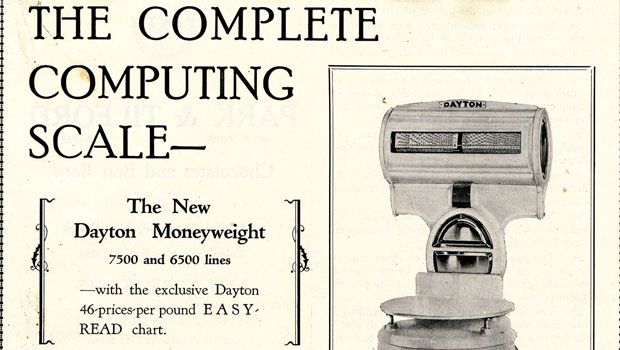
All three companies were combined on June 16, 1911 in Computing Tabulating Recording. She sold scales, working time tracking devices, punched cards for punching cards. The merger was American businessman Charles Ranlett Flint. He bought TMC for 2.3 million American dollars, of which Herman Hollerith received 1.2 million.
In 1914, Thomas Watson took over as CEO and the company began to specialize only in large tabulation machines.
The slogan of the company was the word "Think". During the four years of Watson’s work, the company's revenues doubled to $ 9 billion. The company actively worked with Europe, South America, Asia and Australia. In 1924, another company was renamed - CTR changed its name to International Business Machines. At the same time, the range is expanding, but electric tabs remain the main product for many years. Their company produced and sold until 1976. IBM tabs used in the USSR.
For years, IBM has worked with both government agencies and businesses. Government orders allowed the company to pay employees even during the Great Depression of 1935–1939 and continue research. During the war, IBM's production sites were occupied with weapons - the company produced the M1 carbine and the Browning automatic rifle.

Technology giant IBM stood at the origins of personal computers. It all started, of course, not with ThinkPad notebooks, but with Mark I. This computer is considered to be the first American programmable computer. It was built in 1941. Developers led by Captain 2nd Rank Navy US Howard Aiken, an IBM engineer, used the developments of Charles Babbage.
The computer, assembled from 765,000 parts, reaches a length of 17 meters, its height is 2.5 meters. Machine weighs 4.5 tons. Engineers used 800 kilometers of wires. Every second the machine could perform three operations of addition or subtraction. Multiplication took 6 seconds division - 15.3 seconds. The huge machine replaced twenty operators with adding machines.
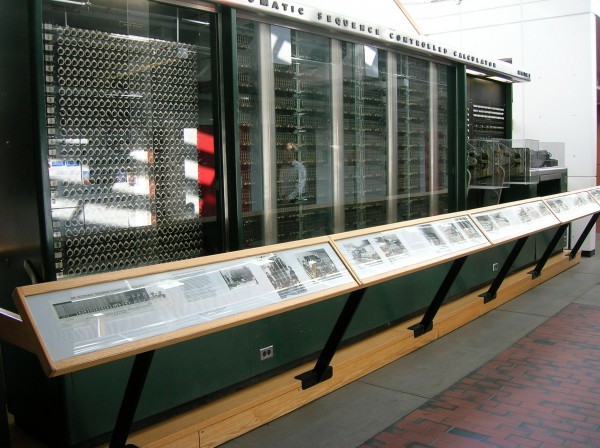
One of the major government orders was working with the SAGE missile defense system. In 1949, the military in the United States was confident that the Soviet Union had bombers who could fly over the North Pole and deliver a bomb to the very center of the country. Such intelligence Americans received after testing the USSR of their first nuclear bomb. The country needed an early detection system, but air defense at that time was collecting data from radar systems manually.
To remedy the situation, in 1950, the US Air Force signed a contract with the MIT to conduct research in the field of air defense and the development of a prototype system. The result of the work was the system SAGE (Semi-Automatic Ground Environment) , which means "semi-automatic ground environment."
The basis of the system became the computers AN / FSQ-7, or XD-1 . Their production was taken over by IBM, earning $ 500 million over the life of the project. The project employed up to 8,000 employees, that is, 25% of the total workforce of the company. Although IBM could have worked on software, the company didn’t undertake this: it was simply unclear where, after the end of the project, it was possible to put 2,000 programmers.
The system was managed by up to 100 operators; in the whole country, up to 24 headquarters were deployed. The screens displayed digitized data with which the operator worked with a light pen. The XD-1 machine weighed 250 tons, consumed 3 megawatts of electricity and had 49,000 lamps in its design. Every second, the XD-1 computer performed up to 75,000 operations, which is ten times higher than the counterparts of that time.
The SAGE system worked until 1983.
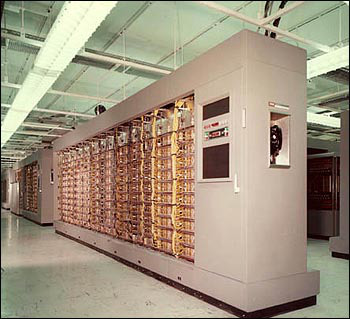
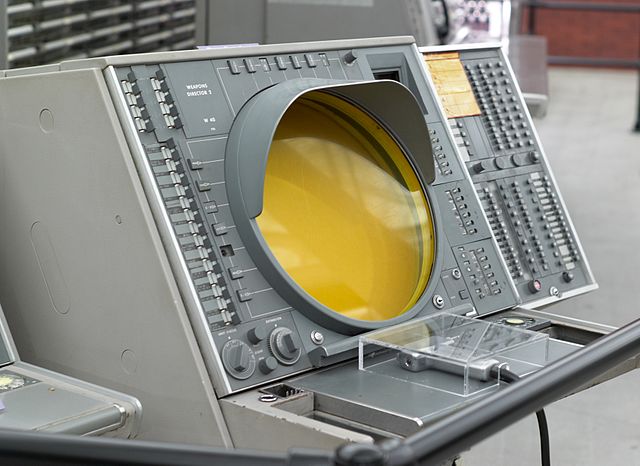
In 1956, the son of Thomas Watson, Thomas Watson Jr., took over as IBM. The company focused on the development and production of computers and software. The team led by John Backus from 1954 to 1957 developed the first high-level programming language in the world, which has a translator and has been further developed until today - FORTRAN . This language has helped the company to increase sales of computers: it has made working with them more “friendly” for users.
The first language standard was developed in 1966 and received the name Fortran 66. In 1977, the standard Fortran 77 was issued. In 1991, Fortran 90 appeared. Fortran 95 was created in 1997. Today the latest version of the standard language - Fortran 2008.

Punch card for language FORTRAN
The first hard drive released by IBM in 1956. The IBM 350 disk storage for 5 million 6-bit characters (about 3.75 MB, if considered in 8-bit) was a component of the IBM 305 RAMAC computer. Inside the repository - 50 discs of 24 inches in diameter (610 mm) with hundreds of recording surfaces.
This commercial computer cost in 1957 at $ 3,200 per month. Today it is about 28,000 dollars.
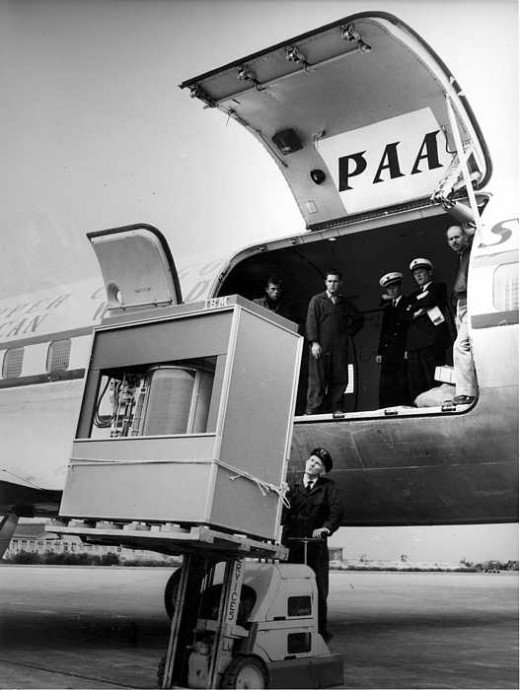
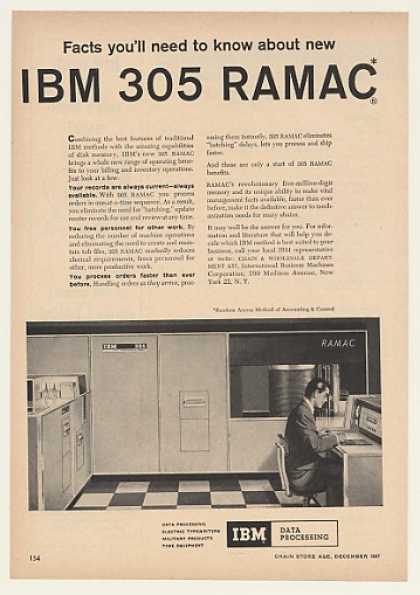
XD-1, which IBM produced for the SAGE system, was not the development of the company - those computers made at MIT. By 1959, IBM made its own computers on transistors that the USAF could already use in an air defense early warning system.
On April 7, 1964, IBM introduced the IBM System / 360 “Mass” Mainframe Line for Business, which contained several systems with different levels of performance, different sizes and, accordingly, different availability in terms of cost. The company spent 5 billion US dollars on the development of System / 360. Taking into account inflation for 2016, it is about 39.66 billion.
IBM / 360 was the first 32-bit computer system. Older models of the line were among the first computers with virtual memory.
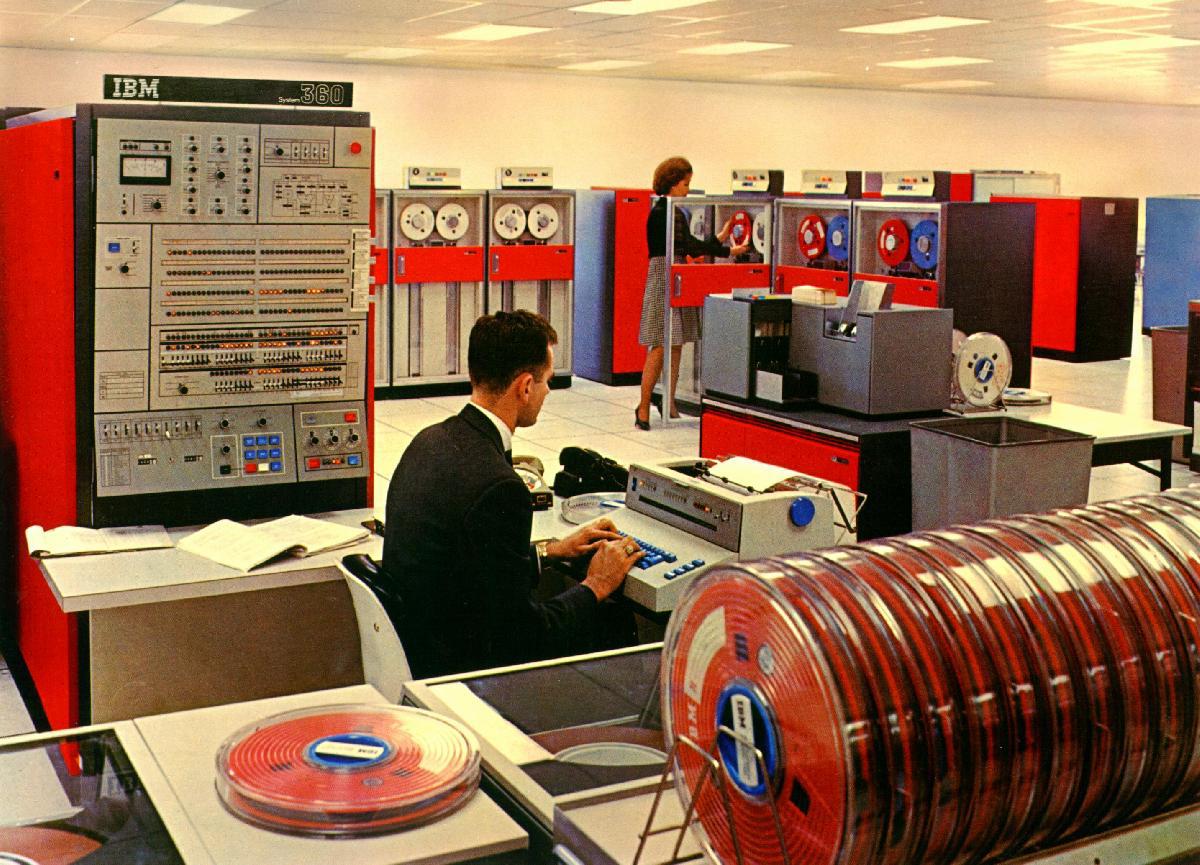

The system uses magnetic disks (IBM 2311 and IBM 2314), data cells (IBM 2321), magnetic tape drives, and had devices for working with paper tapes as storage devices.
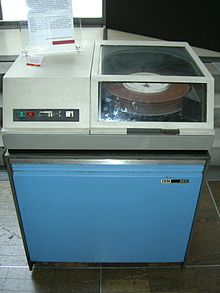
IBM 2311 magnetic disk drive
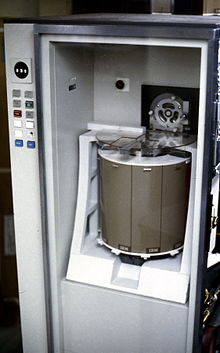
IBM 2321 data cell drive
In 2016, 52 years after the launch of the System / 360 line, IBM continues to release compatible mainframes - the IBM System z line.
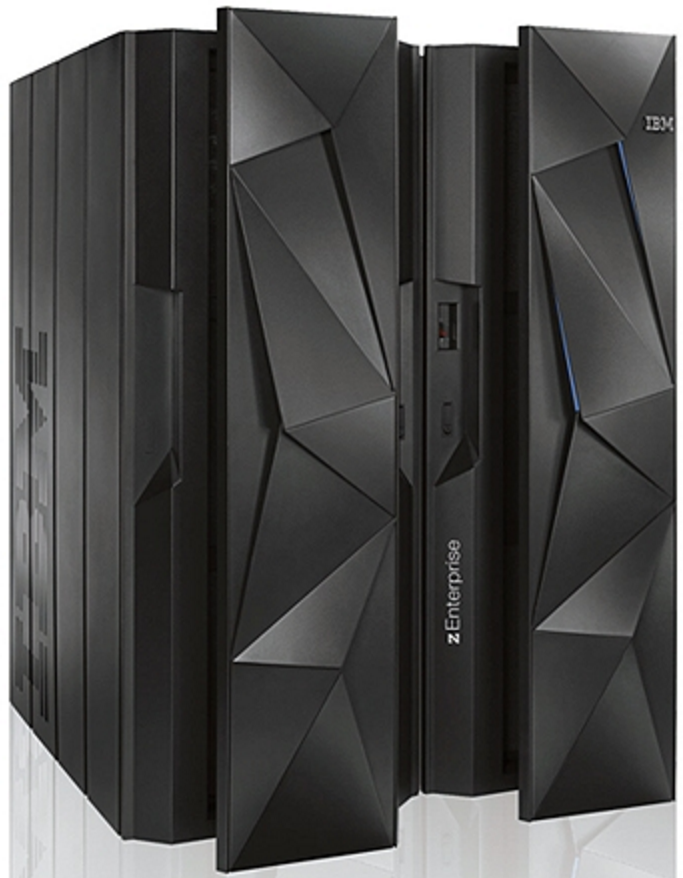
In September 1975, IBM released the 5100 portable personal computer. It worked on an IBM PALM processor with a clock frequency of 1.9 MHz, was equipped with from 16 KB to 64 KB of operational memory and from 32 KB to 64 KB of permanent memory. This professional car cost about $ 20,000, which in terms of money in 2016 is $ 91,420. This solution was only suitable for large businesses.

In 1981, IBM launched the IBM PC line. The computer was built on an Intel 8088 processor with a clock frequency of 4.77 MHz, had from 16 to 256 KB of memory, up to two floppy drives on 5 1/4 inch floppy disks and worked on the DOS operating system from Microsoft.
An important difference from the IBM 5100 was the pricing policy. Now the computer has become massive, affordable (relatively): it would have cost just $ 3,005 in top configuration. For 2016 it is about 8,130 dollars. The budget model, “home”, with 16 KB of RAM, cost $ 1,565, which is about $ 4,200 for today.
In the early 1980s, it was important for the company not to miss the moment of the creation of the personal computer market, to enter it with competitive products. If the company's mainframes were not equal, then Commodore PET, Atari, Apple II and Radio Shack TRS-80 were already on the personal computer market.
By 1988, 25 million IBM-compatible PCs were manufactured, of which 15 million were released by IBM.

In 1992, the company launched another iconic product line: ThinkPad notebooks. The design of laptops has been developed by Richard Sapper , who has advised the company on industrial design since the 1980s. Gray cars reincarnated in elegant black minimalist body. Sapper created the famous trackpoint to control the cursor - the red button in the middle of the keyboard, which has become the hallmark of the line.
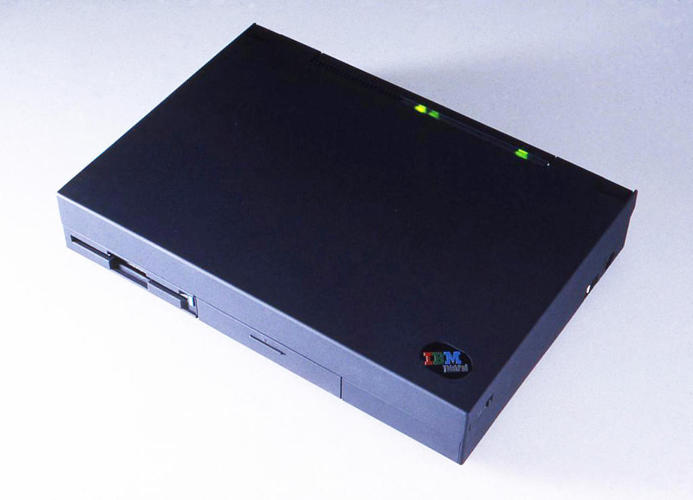
ThinkPad 700c for IBM 1992
The modified ThinkPad 750 model was used by NASA for work in space. Now they are replaced by Lenovo ThinkPad T61P.

ThinkPad X1 for Lenovo, 2012

Some of the inventions made in the laboratories of IBM, for us are commonplace. For example, a magnetic stripe on plastic cards.
Bar codes and perforation were never reliable, and for bank cards in the 1960s it was necessary to come up with a special way to store data. IBM engineer Forrest Perry decided to try to paste the magnetic strip on the card. She broke off. According to legend, his wife told him to try to swim the strip in plastic.
Now the production of cards with a magnetic strip is as follows: a plastic base is printed - both sides of the card are covered with two sheets of laminate, a magnetic strip is fixed on the surface and placed in a thermal press, in which this sandwich is processed at a temperature of 160 degrees.
Today, all bank cards have a magnetic tape, although they increasingly begin to use chips and NFC. The magnetic layer of the card contains three stripes. Earlier on the third track pin code was stored for card operation in ATMs that do not have access to the network. Now only two are used.
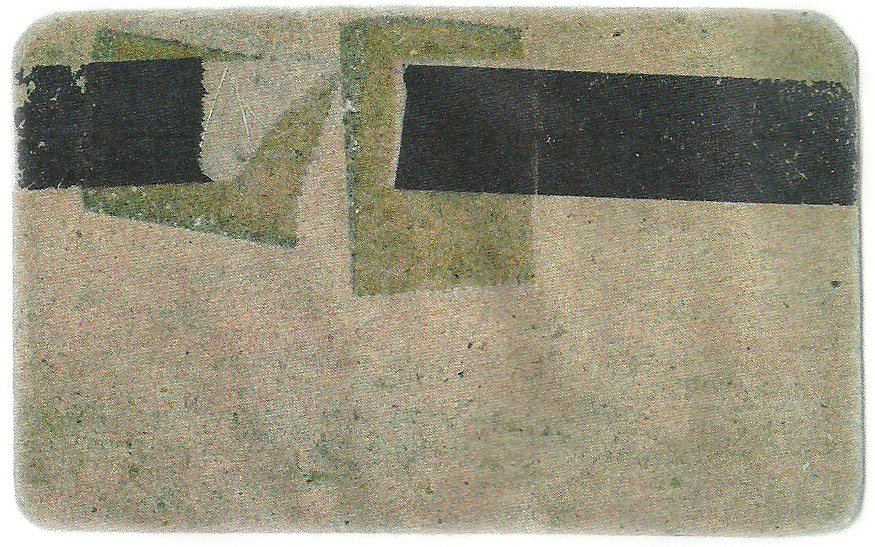
The first prototype of a magnetic stripe card
Another invention that for many years entered the world of information technology - a floppy disk. The magnetic tapes in the reels were a good storage device, but they had one big drawback: the speed was low due to the sequential access to the data. In the 1960s, Alan Shugart’s IBM team tried to correct this deficiency in an IBM lab.
Senior engineer David Noble in 1967 proposed the use of a flexible magnetic disk placed in a protective casing. In 1971, the company introduced the first 8-inch diskette of 80 kilobytes and a drive for it. In the same year, Shugart left the company and founded Shugart Technology, after which he joined the development of mini-floppy disks.

Computer operator uses 8-inch floppy disk
IBM continues to work on methods of storing information, which, as it seems to a simple consumer, have sunk into oblivion. Many people have never seen or held audio tapes and video tapes in their hands, and many have already forgotten what they look like. At the same time, magnetic tapes are still of great importance for business and research centers.
To store the results of the Large Hadron Collider, CERN uses magnetic tape. Clouds with magnetic tapes combines NASA and Discovery TV channel. IBM is improving formats, and in 2015, scientists were able to write data to a magnetic tape with an efficiency of 123 billion bits per square inch. This is higher than the LTO-6 format that has existed since 2012, according to which 2.5 TB of data can be recorded on the middle-class film.
In 2012, IBM, together with Fujifilm, began developing prototype cassettes measuring 10x10x2 centimeters, capable of storing up to 35 terabytes of data each.
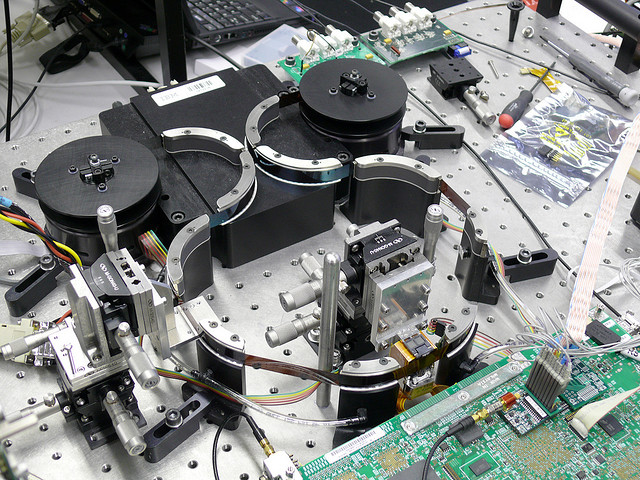
In the laboratories of the company continue to work on various issues that can affect the future of mankind. For example, over artificial intelligence. One of the most famous projects in this area was IBM Watson, a cognitive system that understands, draws conclusions and is able to learn . In 2011, the Watson supercomputer played on the Jeopardy show, the Russian equivalent of which is Own Game.
The use of the system can be very different - from helping to find a gift for the holidays to diagnosis and counseling for oncologists . Oh, and IBM Watson also comes up with recipes .
If we talk about supercomputers, then for 2016 IBM with Sequoia and Mira is in the TOP-10 fourth and sixth positions.
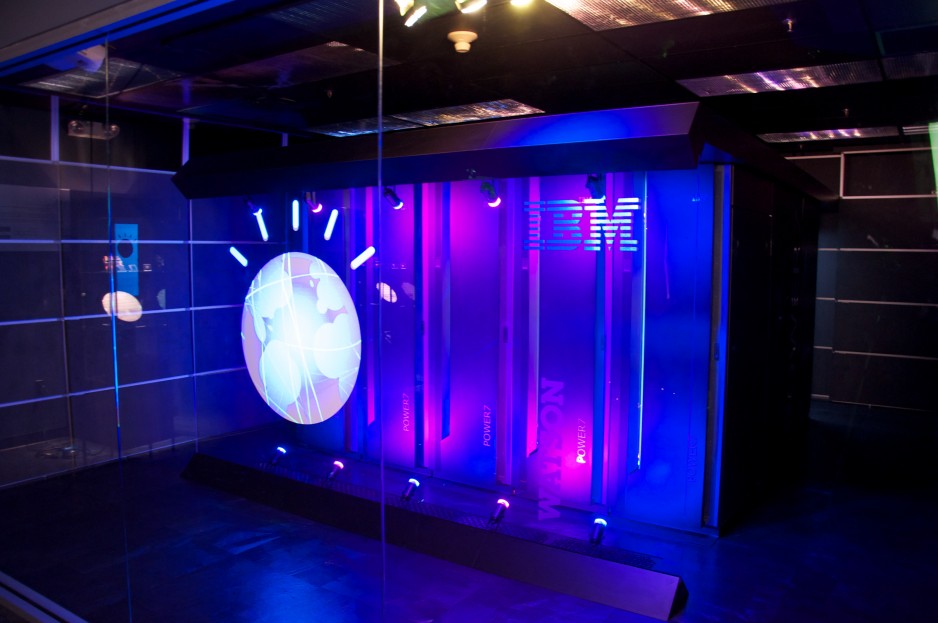
In 2005, Lenovo bought for $ 1.25 billion from IBM a personal computer manufacturing division and became the third largest company in the market. In 2012, Lenovo won the first place in the supply of personal computers through the purchase of IBM computer business. In September 2014, IBM sold the x86 server business.
The company has developed hard drives, floppy disks, bank cards with magnetic stripe, computers, supercomputers. Most of our computers today were created thanks to IBM. The same goes for laptops. Why did the company sell part of its "iron" units?
IBM began to move away from the "iron" in the direction of consulting. In 2002, IBM bought the consulting division of PricewaterhouseCoopers, an auditing company, spending $ 3.5 billion on this. Today, this business brings more than half of the company's revenue.
We'll talk about the US air defense, the first programmable computer, alternative use of production capacity (for the production of rifles), the first mass IBM PC, the ThinkPad notebook line and inventions that have come into our lives for many years.

At the origins of IBM stood Herman Hollerith , an American inventor. He was born into a family of German émigrés, graduated from Columbia University Mining School, became an assistant to Professor W. Trubridge at Columbia, and then assisted him at the census bureau. In the 1880s, Hollerith developed and patented equipment for working with punch cards , which were used in weaving looms since the early 1700s, and from 1822 they were used in a difference machine by Charles Babbage .
')
The invention of the electric tabulation system allowed Hollerith to speed up the process of counting population census results. If we spent eight years on the counting in 1880, then in 1890, thanks to the tabulator, the bureau left it for one year. After the census in the United States, Hollerith was promoted to professor at Columbia University. During the following years, his invention was used to conduct censuses in several countries, including Austria, Canada, Italy, and France. Understanding the potential of his invention, Hollerith in 1896 opens the Tabulating Machine Company. TMC sells its cars to railway companies, government agencies, and international trade.
In Russia, until the end of the XIX century there was no accurate data on the population. These figures are important for the state as a minimum in order to calculate the number of citizens liable for military service, as well as for solving a host of other issues of governing the country.
 In August 1895, N. A. Troinitsky, Director of the Center for Statistics, at the session of the International Statistical Institute presented to the colleagues the Regulation on the General Census in Russia scheduled for 1897 . Hollerith also spoke at this session. A year after this meeting, Hollerith was invited to Russia to sign a contract and conduct a census. The Tabulating Machine Company, which Hollerith opened in 1896, provided Russia with 35 previously used cars for rent and sold 70 tabulators with sorting machines and 500 rotary hammers. To reduce the cost of transporting equipment, some parts were produced on site, in St. Petersburg.
In August 1895, N. A. Troinitsky, Director of the Center for Statistics, at the session of the International Statistical Institute presented to the colleagues the Regulation on the General Census in Russia scheduled for 1897 . Hollerith also spoke at this session. A year after this meeting, Hollerith was invited to Russia to sign a contract and conduct a census. The Tabulating Machine Company, which Hollerith opened in 1896, provided Russia with 35 previously used cars for rent and sold 70 tabulators with sorting machines and 500 rotary hammers. To reduce the cost of transporting equipment, some parts were produced on site, in St. Petersburg.The complete set consisted of one tabulator, which summarized the signs of the same name, thirty punchers for preparing punched cards, two sorting machines for grouping cards. Census sheets were sent to headquarters, in this case, to the Center of statistical control of the Russian Empire. More than two and a half thousand people worked here in several departments. In the markup opposite the answers, the code of the sign was put, in the check mark - they checked if there were any errors, and in the breakdown code the codes were transferred to punch cards, each of which corresponded to one person. The last branch, machine, made calculations using tabs and sorting machines. It counted the results and grouped punch cards. Unfortunately, in Russia, the census took eight years because of the negligence of some of the people responsible for the process.

The last tabulator that was used during the census in the Russian Empire. Photo: Polytechnic Museum
In 1901, in parallel with the TMC in the United States opened the Computing Scale Company, which produced the scales. These scales simplify the sellers life, allowing you to quickly calculate the cost of goods. The third "pillar" of the corporation was the International Time Recording Company, a manufacturer of time tracking systems.

All three companies were combined on June 16, 1911 in Computing Tabulating Recording. She sold scales, working time tracking devices, punched cards for punching cards. The merger was American businessman Charles Ranlett Flint. He bought TMC for 2.3 million American dollars, of which Herman Hollerith received 1.2 million.
In 1914, Thomas Watson took over as CEO and the company began to specialize only in large tabulation machines.
The slogan of the company was the word "Think". During the four years of Watson’s work, the company's revenues doubled to $ 9 billion. The company actively worked with Europe, South America, Asia and Australia. In 1924, another company was renamed - CTR changed its name to International Business Machines. At the same time, the range is expanding, but electric tabs remain the main product for many years. Their company produced and sold until 1976. IBM tabs used in the USSR.
For years, IBM has worked with both government agencies and businesses. Government orders allowed the company to pay employees even during the Great Depression of 1935–1939 and continue research. During the war, IBM's production sites were occupied with weapons - the company produced the M1 carbine and the Browning automatic rifle.

Technology giant IBM stood at the origins of personal computers. It all started, of course, not with ThinkPad notebooks, but with Mark I. This computer is considered to be the first American programmable computer. It was built in 1941. Developers led by Captain 2nd Rank Navy US Howard Aiken, an IBM engineer, used the developments of Charles Babbage.
The computer, assembled from 765,000 parts, reaches a length of 17 meters, its height is 2.5 meters. Machine weighs 4.5 tons. Engineers used 800 kilometers of wires. Every second the machine could perform three operations of addition or subtraction. Multiplication took 6 seconds division - 15.3 seconds. The huge machine replaced twenty operators with adding machines.

One of the major government orders was working with the SAGE missile defense system. In 1949, the military in the United States was confident that the Soviet Union had bombers who could fly over the North Pole and deliver a bomb to the very center of the country. Such intelligence Americans received after testing the USSR of their first nuclear bomb. The country needed an early detection system, but air defense at that time was collecting data from radar systems manually.
To remedy the situation, in 1950, the US Air Force signed a contract with the MIT to conduct research in the field of air defense and the development of a prototype system. The result of the work was the system SAGE (Semi-Automatic Ground Environment) , which means "semi-automatic ground environment."
The basis of the system became the computers AN / FSQ-7, or XD-1 . Their production was taken over by IBM, earning $ 500 million over the life of the project. The project employed up to 8,000 employees, that is, 25% of the total workforce of the company. Although IBM could have worked on software, the company didn’t undertake this: it was simply unclear where, after the end of the project, it was possible to put 2,000 programmers.
The system was managed by up to 100 operators; in the whole country, up to 24 headquarters were deployed. The screens displayed digitized data with which the operator worked with a light pen. The XD-1 machine weighed 250 tons, consumed 3 megawatts of electricity and had 49,000 lamps in its design. Every second, the XD-1 computer performed up to 75,000 operations, which is ten times higher than the counterparts of that time.
The SAGE system worked until 1983.


In 1956, the son of Thomas Watson, Thomas Watson Jr., took over as IBM. The company focused on the development and production of computers and software. The team led by John Backus from 1954 to 1957 developed the first high-level programming language in the world, which has a translator and has been further developed until today - FORTRAN . This language has helped the company to increase sales of computers: it has made working with them more “friendly” for users.
The first language standard was developed in 1966 and received the name Fortran 66. In 1977, the standard Fortran 77 was issued. In 1991, Fortran 90 appeared. Fortran 95 was created in 1997. Today the latest version of the standard language - Fortran 2008.

Punch card for language FORTRAN
The first hard drive released by IBM in 1956. The IBM 350 disk storage for 5 million 6-bit characters (about 3.75 MB, if considered in 8-bit) was a component of the IBM 305 RAMAC computer. Inside the repository - 50 discs of 24 inches in diameter (610 mm) with hundreds of recording surfaces.
This commercial computer cost in 1957 at $ 3,200 per month. Today it is about 28,000 dollars.


XD-1, which IBM produced for the SAGE system, was not the development of the company - those computers made at MIT. By 1959, IBM made its own computers on transistors that the USAF could already use in an air defense early warning system.
On April 7, 1964, IBM introduced the IBM System / 360 “Mass” Mainframe Line for Business, which contained several systems with different levels of performance, different sizes and, accordingly, different availability in terms of cost. The company spent 5 billion US dollars on the development of System / 360. Taking into account inflation for 2016, it is about 39.66 billion.
IBM / 360 was the first 32-bit computer system. Older models of the line were among the first computers with virtual memory.


The system uses magnetic disks (IBM 2311 and IBM 2314), data cells (IBM 2321), magnetic tape drives, and had devices for working with paper tapes as storage devices.

IBM 2311 magnetic disk drive

IBM 2321 data cell drive
In 2016, 52 years after the launch of the System / 360 line, IBM continues to release compatible mainframes - the IBM System z line.

In September 1975, IBM released the 5100 portable personal computer. It worked on an IBM PALM processor with a clock frequency of 1.9 MHz, was equipped with from 16 KB to 64 KB of operational memory and from 32 KB to 64 KB of permanent memory. This professional car cost about $ 20,000, which in terms of money in 2016 is $ 91,420. This solution was only suitable for large businesses.

In 1981, IBM launched the IBM PC line. The computer was built on an Intel 8088 processor with a clock frequency of 4.77 MHz, had from 16 to 256 KB of memory, up to two floppy drives on 5 1/4 inch floppy disks and worked on the DOS operating system from Microsoft.
An important difference from the IBM 5100 was the pricing policy. Now the computer has become massive, affordable (relatively): it would have cost just $ 3,005 in top configuration. For 2016 it is about 8,130 dollars. The budget model, “home”, with 16 KB of RAM, cost $ 1,565, which is about $ 4,200 for today.
In the early 1980s, it was important for the company not to miss the moment of the creation of the personal computer market, to enter it with competitive products. If the company's mainframes were not equal, then Commodore PET, Atari, Apple II and Radio Shack TRS-80 were already on the personal computer market.
By 1988, 25 million IBM-compatible PCs were manufactured, of which 15 million were released by IBM.

In 1992, the company launched another iconic product line: ThinkPad notebooks. The design of laptops has been developed by Richard Sapper , who has advised the company on industrial design since the 1980s. Gray cars reincarnated in elegant black minimalist body. Sapper created the famous trackpoint to control the cursor - the red button in the middle of the keyboard, which has become the hallmark of the line.

ThinkPad 700c for IBM 1992
The modified ThinkPad 750 model was used by NASA for work in space. Now they are replaced by Lenovo ThinkPad T61P.

ThinkPad X1 for Lenovo, 2012

Some of the inventions made in the laboratories of IBM, for us are commonplace. For example, a magnetic stripe on plastic cards.
Bar codes and perforation were never reliable, and for bank cards in the 1960s it was necessary to come up with a special way to store data. IBM engineer Forrest Perry decided to try to paste the magnetic strip on the card. She broke off. According to legend, his wife told him to try to swim the strip in plastic.
Now the production of cards with a magnetic strip is as follows: a plastic base is printed - both sides of the card are covered with two sheets of laminate, a magnetic strip is fixed on the surface and placed in a thermal press, in which this sandwich is processed at a temperature of 160 degrees.
Today, all bank cards have a magnetic tape, although they increasingly begin to use chips and NFC. The magnetic layer of the card contains three stripes. Earlier on the third track pin code was stored for card operation in ATMs that do not have access to the network. Now only two are used.

The first prototype of a magnetic stripe card
Another invention that for many years entered the world of information technology - a floppy disk. The magnetic tapes in the reels were a good storage device, but they had one big drawback: the speed was low due to the sequential access to the data. In the 1960s, Alan Shugart’s IBM team tried to correct this deficiency in an IBM lab.
Senior engineer David Noble in 1967 proposed the use of a flexible magnetic disk placed in a protective casing. In 1971, the company introduced the first 8-inch diskette of 80 kilobytes and a drive for it. In the same year, Shugart left the company and founded Shugart Technology, after which he joined the development of mini-floppy disks.

Computer operator uses 8-inch floppy disk
IBM continues to work on methods of storing information, which, as it seems to a simple consumer, have sunk into oblivion. Many people have never seen or held audio tapes and video tapes in their hands, and many have already forgotten what they look like. At the same time, magnetic tapes are still of great importance for business and research centers.
To store the results of the Large Hadron Collider, CERN uses magnetic tape. Clouds with magnetic tapes combines NASA and Discovery TV channel. IBM is improving formats, and in 2015, scientists were able to write data to a magnetic tape with an efficiency of 123 billion bits per square inch. This is higher than the LTO-6 format that has existed since 2012, according to which 2.5 TB of data can be recorded on the middle-class film.
In 2012, IBM, together with Fujifilm, began developing prototype cassettes measuring 10x10x2 centimeters, capable of storing up to 35 terabytes of data each.

In the laboratories of the company continue to work on various issues that can affect the future of mankind. For example, over artificial intelligence. One of the most famous projects in this area was IBM Watson, a cognitive system that understands, draws conclusions and is able to learn . In 2011, the Watson supercomputer played on the Jeopardy show, the Russian equivalent of which is Own Game.
The use of the system can be very different - from helping to find a gift for the holidays to diagnosis and counseling for oncologists . Oh, and IBM Watson also comes up with recipes .
If we talk about supercomputers, then for 2016 IBM with Sequoia and Mira is in the TOP-10 fourth and sixth positions.

In 2005, Lenovo bought for $ 1.25 billion from IBM a personal computer manufacturing division and became the third largest company in the market. In 2012, Lenovo won the first place in the supply of personal computers through the purchase of IBM computer business. In September 2014, IBM sold the x86 server business.
The company has developed hard drives, floppy disks, bank cards with magnetic stripe, computers, supercomputers. Most of our computers today were created thanks to IBM. The same goes for laptops. Why did the company sell part of its "iron" units?
IBM began to move away from the "iron" in the direction of consulting. In 2002, IBM bought the consulting division of PricewaterhouseCoopers, an auditing company, spending $ 3.5 billion on this. Today, this business brings more than half of the company's revenue.
Source: https://habr.com/ru/post/372859/
All Articles